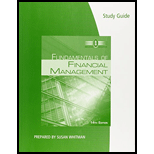
a.
To compute: The net operating working capital of Company B.
Financial Statements: A part of annual report that is attributed to the financials of the company for an accounting period is called financial statements. These include income statement, statement of
Net Operating Working Capital: The difference of current assets and current liabilities is called working capital. When only accounts payable and accruals are considered instead of total current liabilities, the difference is called net operating working capital.
a.
Answer to Problem 14P
The Company B has net operating working capital of $53,725 and $44,000 in 2015 and 2014, respectively
Explanation of Solution
Solution:
Given (for 2015),
Accounts payable are $10,800.
Accruals are $7,600.
Current assets are $72,125.
Formula to compute net operating working capital,
Substitute $10,800 for accounts payable, $7,600 for accruals and $72,125 for current assets.
Given (for 2014),
Accounts payable are $9,000.
Accruals are $6,000.
Current assets are $59,000.
Formula to compute net operating working capital,
Substitute $9,000 for accounts payable, $6,000 for accruals and $59,000 for current assets.
Therefore the Company B has net operating working capital of $53,725 and $44,000 in 2015 and 2014, respectively.
b.
To compute: The
Free Cash Flow: The cash generated over and above required by business operations and capital expenditure is called free cash flow. Statement of cash flow reports the cash flow generated or consumed by the business.
b.
Answer to Problem 14P
The free cash flow in 2015 for Company B is $11,175.
Explanation of Solution
Determine the capital expenditure
Therefore the capital expenditure is $8,000
Determine the free cash flow for 2015
Therefore the free cash flow in 2015 for Company B is $11,175.
c.
To prepare: The statement of
Statement of Stockholders’ Equity: Statement of stockholders’ equity shows the opening and closing balance of stockholder’s equity with the changes occurred during the accounting period.
c.
Answer to Problem 14P
Company B has stockholders’ equity of $82,025 at the end of year 2015.
Explanation of Solution
Statement of stockholders’ equity:
| Shares | Amount |
Retained Earnings |
Total Stockholders’ Equity | |
| Balances, December 31, 2014 | 5,000 | 50,000 | 20,850 | 70,850 |
| Net income, 2015 | 22,350 | |||
| Cash dividends | (11,175) | |||
| Additional to retained earnings | 11,175 | |||
| Balances, December 31, 2015 | 82,025 |
d.
To compute: The economic value added for Company B.
Economic Value Added (EVA): It is a measure along with market value added, to evaluate management’s performance. It considers the
d.
Answer to Problem 14P
The economic value added for Company B is $13,027.50.
Explanation of Solution
Given,
Net operating income is $39,000.
Income tax rate is 40%.
Total invested capital $103,725.
After tax percentage cost of capital is 10%.
Formula to compute economic value added,
Substitute $39,000 for operating income, 40% for tax rate, $97,025 for invested capital and 10% for after tax percentage cost of capital.
Therefore the economic value added for Company B is $13,027.50.
Working note:
Calculation of total invested capital,
e.
To compute: The market value added for Company B in 2015.
Market Value Added: The measure to evaluate management’s performance in a company’s operations and growth, market value added considers the market value of company’s outstanding shares. It reports the market value over and above the book value of those outstanding shares.
e.
Answer to Problem 14P
The market value added for Company B in 2015 is $17,975.
Explanation of Solution
Given,
Book value of common equity is $50,000.
Stock price is $20 per share.
Number of shares outstanding are 5,000.
Formula to compute market value added,
Substitute $50,000 for common book value of equity, $20 for stock price and 5,000 for number of shares outstanding.
Therefore the market value added for Company B in 2015 is $17,975.
Want to see more full solutions like this?
Chapter 3 Solutions
Study Guide For Brigham/houston's Fundamentals Of Financial Management, 14th
- What is ethical dilemma?arrow_forward$1.35 Million for the below question is incorrect, Machine A is $1.81 and Machine B is $0.46 Million. The Perez Company has the opportunity to invest in one of two mutually exclusive machines that will produce a product it will need for the foreseeable future. Machine A costs $8 million but realizes after-tax inflows of $4.5 million per year for 4 years. After 4 years, the machine must be replaced. Machine B costs $17 million and realizes after-tax inflows of $4 million per year for 8 years, after which it must be replaced. Assume that machine prices are not expected to rise because inflation will be offset by cheaper components used in the machines. The cost of capital is 13%. Using the replacement chain approach to project analysis, by how much would the value of the company increase if it accepted the better machine? Round your answer to two decimal places. 1.) $1.35 millionarrow_forwardBuggies-Are-Us Steady Freddie, Inc Gang Buster Group g = 0 g = 55% Year 1 $3.51 (i.e., dividends are expected to remain at $3.053.05/share) (for the foreseeable future) Year 2 $4.04 Year 3 $4.63 Year 4 $5.36 Year 5 $6.15 Year 6 and beyond: g = 55%arrow_forward
- Project S has a cost of $10,000 and is expected to produce benefits (cash flows) of $3,000 per year for 5 years. Project L costs $25,000 and is expected to produce cash flows of $7,400 per year for 5 years. Calculate the two projects' NPVs, assuming a cost of capital of 12%. Do not round intermediate calculations. Round your answers to the nearest cent. Calculate the two projects' PIs, assuming a cost of capital of 12%. Do not round intermediate calculations. Round your answers to three decimal places. Project L is not 1.07arrow_forwardWilbur and Orville are brothers. They're both serious investors, but they have different approaches to valuing stocks. Wilbur, the older brother, likes to use the dividend valuation model. Orville prefers the free cash flow to equity valuation model. As it turns out, right now, both of them are looking at the same stock-Wright First Aerodynmaics, Inc. (WFA). The company has been listed on the NYSE for over 50 years and is widely regarded as a mature, rock-solid, dividend-paying stock. The brothers have gathered the following information about WFA's stock: Current dividend (D) = $2.30/share Current free cash flow (FCF) = $1.5 million Expected growth rate of dividends and cash flows (g) = 5% Required rate of return (r) = 14% Shares outstanding 500,000 shares How would Wilbur and Orville each value this stock?arrow_forwardCompany P/S Multiples Facebook 13.33 Snap 18.22 Twitter 13.27arrow_forward
- The Perez Company has the opportunity to invest in one of two mutually exclusive machines that will produce a product it will need for the foreseeable future. Machine A costs $8 million but realizes after-tax inflows of $4.5 million per year for 4 years. After 4 years, the machine must be replaced. Machine B costs $17 million and realizes after-tax inflows of $4 million per year for 8 years, after which it must be replaced. Assume that machine prices are not expected to rise because inflation will be offset by cheaper components used in the machines. The cost of capital is 13%. Using the replacement chain approach to project analysis, by how much would the value of the company increase if it accepted the better machine? Round your answer to two decimal places. 1.) $ millionarrow_forwardWilbur and Orville are brothers. They're both serious investors, but they have different approaches to valuing stocks. Wilbur, the older brother, likes to use the dividend valuation model. Orville prefers the free cash flow to equity valuation model. As it turns out, right now, both of them are looking at the same stock-Wright First Aerodynmaics, Inc. (WFA). The company has been listed on the NYSE for over 50 years and is widely regarded as a mature, rock-solid, dividend-paying stock. The brothers have gathered the following information about WFA's stock: Current dividend (D) = $3.30/share Current free cash flow (FCF) = $1.5 million Expected growth rate of dividends and cash flows (g)=8% Required rate of return (r) = 13% Shares outstanding 500,000 shares How would Wilbur and Orville each value this stock? The stock price from Wilbur's valuation is $ (Round to the nearest cent.)arrow_forwardThe Perez Company has the opportunity to invest in one of two mutually exclusive machines that will produce a product it will need for the foreseeable future. Machine A costs $8 million but realizes after-tax inflows of $4.5 million per year for 4 years. After 4 years, the machine must be replaced. Machine B costs $17 million and realizes after-tax inflows of $4 million per year for 8 years, after which it must be replaced. Assume that machine prices are not expected to rise because inflation will be offset by cheaper components used in the machines. The cost of capital is 13%. Using the replacement chain approach to project analysis, by how much would the value of the company increase if it accepted the better machine? Round your answer to two decimal places. 1.) $ million What is the equivalent annual annuity for each machine? Do not round intermediate calculations. Round your answers to two decimal places. 2.) Machine A: $ million 3.) Machine B: $ millionarrow_forward
- You expect to have $29,865. You plan to make X savings contribution of $1,690 per month. The expected return is 0.92 percent per month and the first regular savings contribution will be made later today. What is X? Round to 2 decimal places.arrow_forwardCompany P/S Multiples Facebook 13.67 Snap 18.76 Twitter 13.55arrow_forwardEnergy Resources generated an EPS of $4.38 over the last 12 months. The company's earnings are expected to grow by 30.7% next year, and because there will be no significant change in the number of shares outstanding, EPS should grow at about the same rate. You feel the stock should trade at a P/E of around 30 times earnings. Use the P/E approach to set a value on this stock. Using the P/E approach, the value on this stock is $ (Round to the nearest cent.)arrow_forward
 EBK CONTEMPORARY FINANCIAL MANAGEMENTFinanceISBN:9781337514835Author:MOYERPublisher:CENGAGE LEARNING - CONSIGNMENT
EBK CONTEMPORARY FINANCIAL MANAGEMENTFinanceISBN:9781337514835Author:MOYERPublisher:CENGAGE LEARNING - CONSIGNMENT Financial Accounting: The Impact on Decision Make...AccountingISBN:9781305654174Author:Gary A. Porter, Curtis L. NortonPublisher:Cengage Learning
Financial Accounting: The Impact on Decision Make...AccountingISBN:9781305654174Author:Gary A. Porter, Curtis L. NortonPublisher:Cengage Learning Fundamentals Of Financial Management, Concise Edi...FinanceISBN:9781337902571Author:Eugene F. Brigham, Joel F. HoustonPublisher:Cengage Learning
Fundamentals Of Financial Management, Concise Edi...FinanceISBN:9781337902571Author:Eugene F. Brigham, Joel F. HoustonPublisher:Cengage Learning PFIN (with PFIN Online, 1 term (6 months) Printed...FinanceISBN:9781337117005Author:Randall Billingsley, Lawrence J. Gitman, Michael D. JoehnkPublisher:Cengage Learning
PFIN (with PFIN Online, 1 term (6 months) Printed...FinanceISBN:9781337117005Author:Randall Billingsley, Lawrence J. Gitman, Michael D. JoehnkPublisher:Cengage Learning





